The 2012 June 5-6 transit of Venus (ToV) is over, and there won't be another one till 2117! Many RASC members successfully viewed the ToV here and abroad, and you can find the graphic record of the observations―and of the astronomers making them―here.
Note: all images are copyright of the attributed photographers and graphic artists, and must not be used without prior permission
|
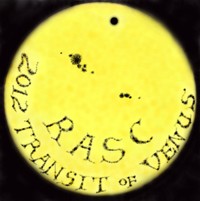 |
Dr. Roy Bishop, Halifax Centre
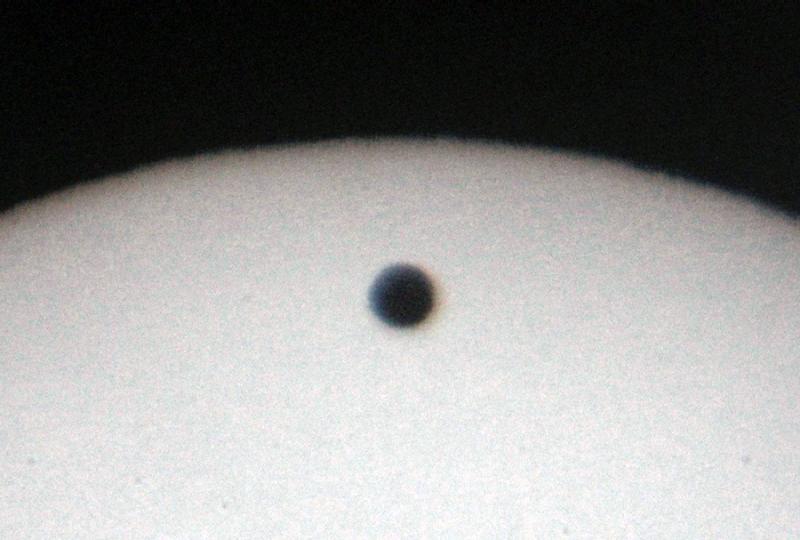 |
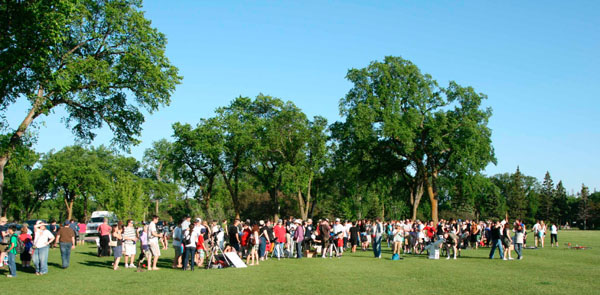 |
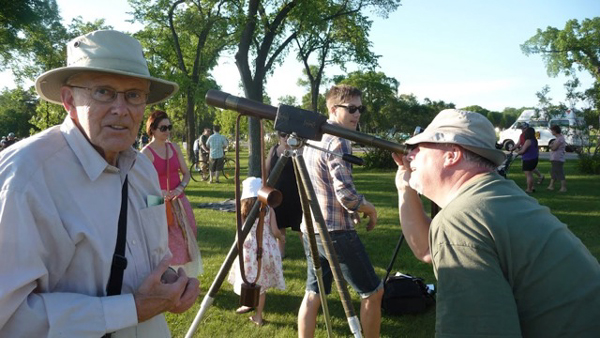 |
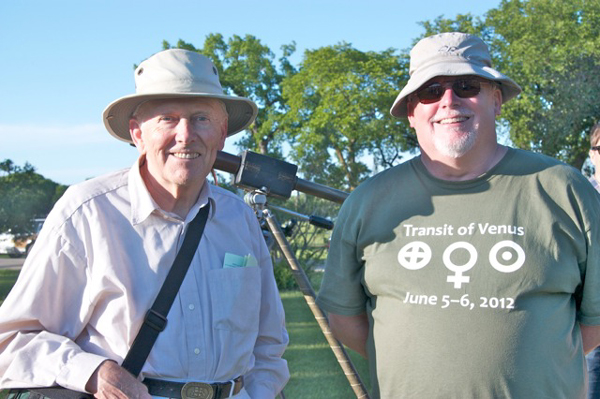 |
|
Dr. Bishop (editor of the Observer's Handbook 1982-2000), and Dave Chapman, editor of the Observer's Handbook 2012-). |
|
Dr. Bishop writes:
During the week before the transit I monitored the weather forecasts for Halifax, Toronto, Winnipeg, Calgary, and Vancouver. Winnipeg had, by far, the best prospects for clear skies on June 5, so on June 3 I booked a flight for June 4 to Winnipeg, plus another for June 6 on to Vancouver where I have family. (I returned to Nova Scotia on June 10).
During the flight to Winnipeg there was solid cloud cover from Halifax to southern Ontario. There were some clear areas around Lake Huron, but the sky was not entirely clear until we reached the Manitoba border. Two days later I encountered solid cloud before reaching Saskatchewan, a few clear areas in southern Alberta, then solid overcast from there to, and including, Vancouver.
The Winnipeg sky was completely clear on June 5, except for a few small cumulus clouds mid-day which were not a problem. The transit was in view for more than 4 hours.
I took a very-portable, 2-inch refractor that I bought 56 years ago (and a camera tripod to hold it). The telescope was made in London, England, of brass construction, covered in leather, with uncoated optics. Before I left home I sandwiched a piece of Baader solar filter between the two lenses of its objective.
I watched the first half hour of the transit by myself, from an open corner of a parking garage beside the Winnipeg airport terminal building. About 30 s after the predicted time of first contact I detected a small notch in the Sun and sat mesmerized as Venus ever so slowly moved in front of the solar disk.
Half an hour later I took a taxi to Assiniboine Park where the RASC Winnipeg Centre was giving a public observing session. Over the next few hours until sunset approximately 2000 people viewed the transit from perhaps three dozen telescopes, including mine. Only two people were there from Nova Scotia: myself and Dave Chapman.
I am enclosing two rather fuzzy photos of the transit I took in Winnipeg. My minimal, portable equipment was part of the problem. I held my camera afocally at the eyepiece of a 2-inch terrestrial refractor, with a solar filter. Some air turbulence and scattered light also degraded the images.
One image was taken at 22:18 UTC, about 4 minutes before second contact for Winnipeg. The other was at 22:58 UTC.
The two views of the transit I remember most were the first notch near the top portion of the Sun, and 4.5 hours later when some distant tree branches slowly rose with the turning Earth to cover an elliptical Sun. A distant flying bird joined Venus in silhouette against the solar disk as that apparition, which I would never see again, vanished behind the trees.
Dave Chapman, Halifax Centre
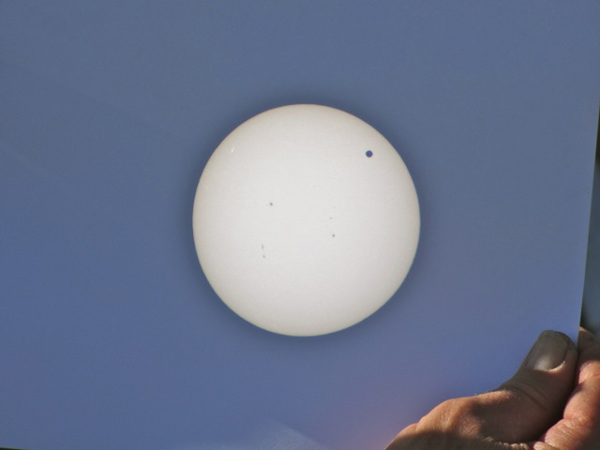 |
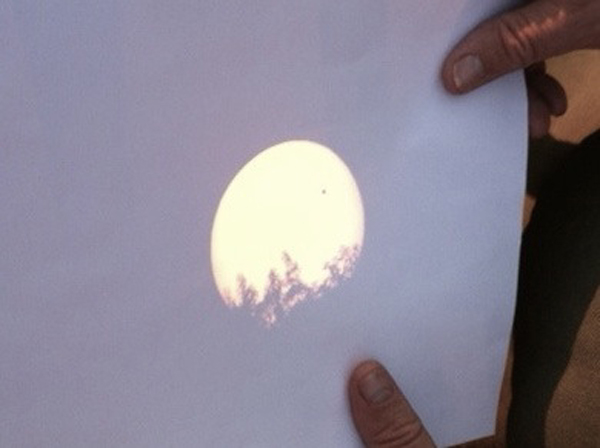 |
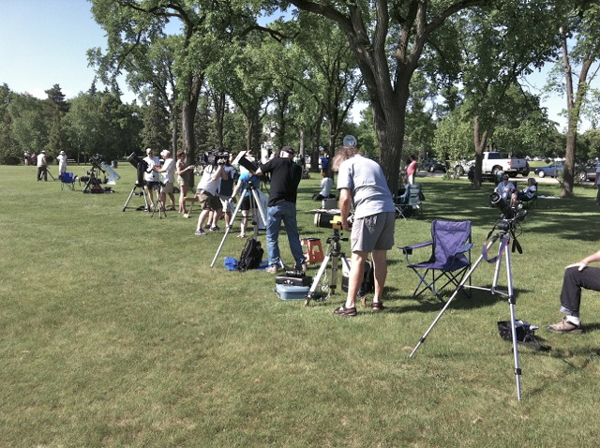 |
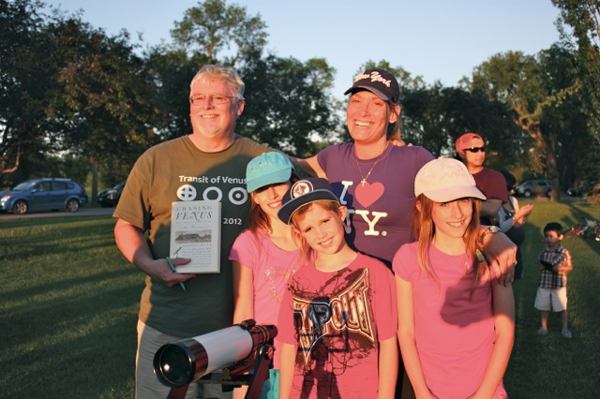 |
photos by Bob Dueck, Karla Weir, Dave Chapman, & Andrea Misner
Dave writes:
To be honest, initially I was not that excited about the 2012 Transit of Venus but I resolved to view it from Halifax if the sky turned out to be clear. As the event approached, there was much discussion of the event, including the historical-scientific significance, and I started to anticipate the transit more and more. When it became apparent that the weather was almost certainly going to be awful in Halifax, I had a decision to make: stay home and be grumpy, or find a place where the sky was likely to be clear, and go there at the last minute.
Day after day for the week leading up to the transit, I pored over the Environment Canada forecasts for accessible cities with clear skies, friends, and not-too-expensive air fares. It was boiling down to Hamilton vs. Winnipeg, and on the Sunday before the Tuesday transit, I chose Winnipeg, because the forecast had consistently clear skies for that city from Monday through Wednesday. Finally, the Clear Sky Chart confirmed that Winnipeg would be clear. Moreover, Roy Bishop had reached precisely the same conclusion: Winnipeg it is! So I bought my ticket for Monday and off I went. I arrived about 6:00 p.m. and was able to visit family that night and the next day before heading off to the observing site, Assiniboine Park.
Although I wanted to observe somewhat privately for first and second contacts, I soon got swept up in the public event organized by Andrea Misner and other Winnipeg RASCals. Many people said they the view through my “small” TeleVue 70 mm refractor.
We also discovered that eyepiece projection onto a white card was effective in sharing the view with groups, especially families with young children and casual photographers.
I do not regret for one instant the journey to Winnipeg to see the 2012 Transit of Venus. It was an amazing sight, the weather was great, and the people were in a festive mood. It was a once-in-a-lifetime event, and I was pleased to share it with Roy and other RASC members. A truly memorable day.
- Log in to post comments
